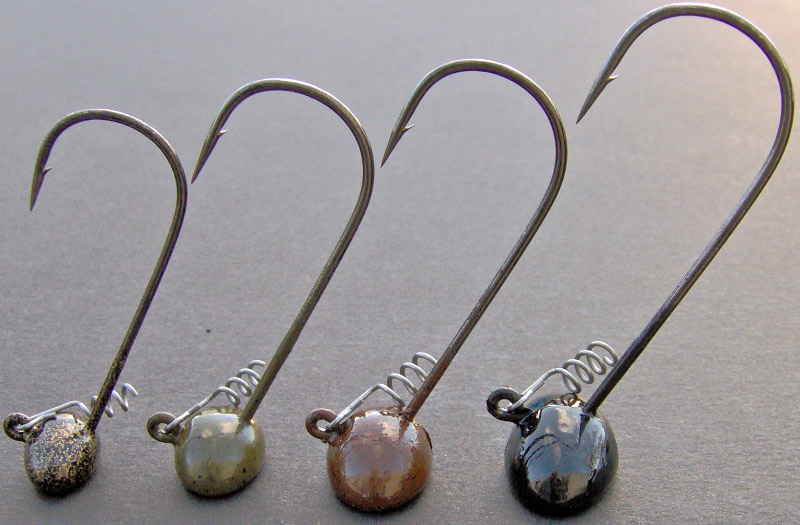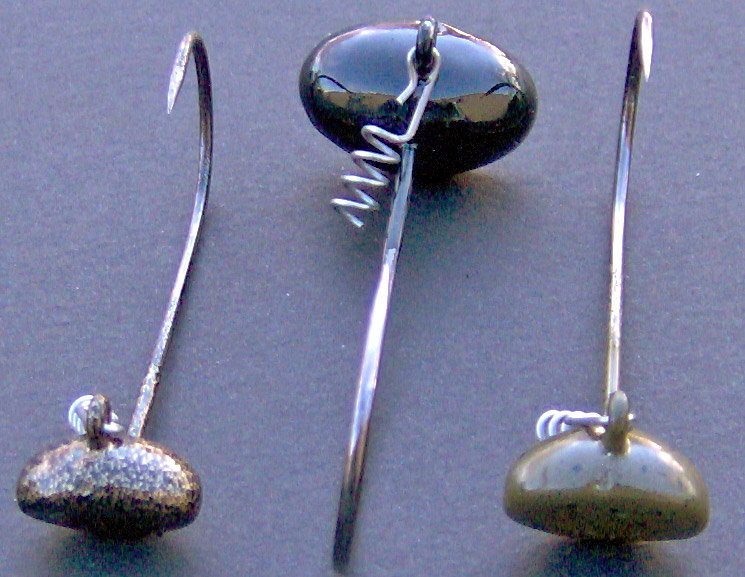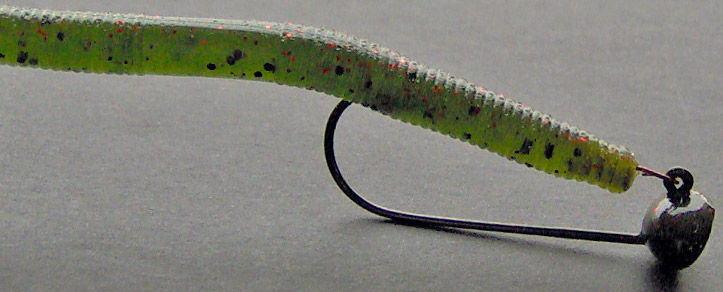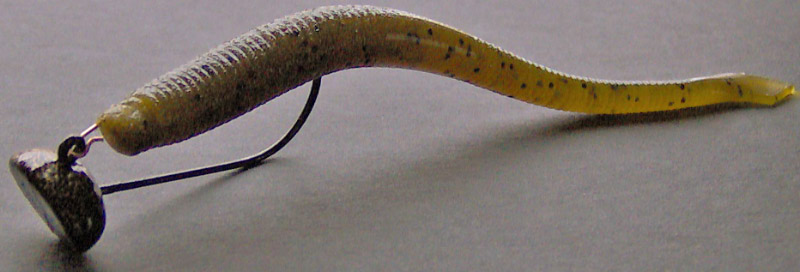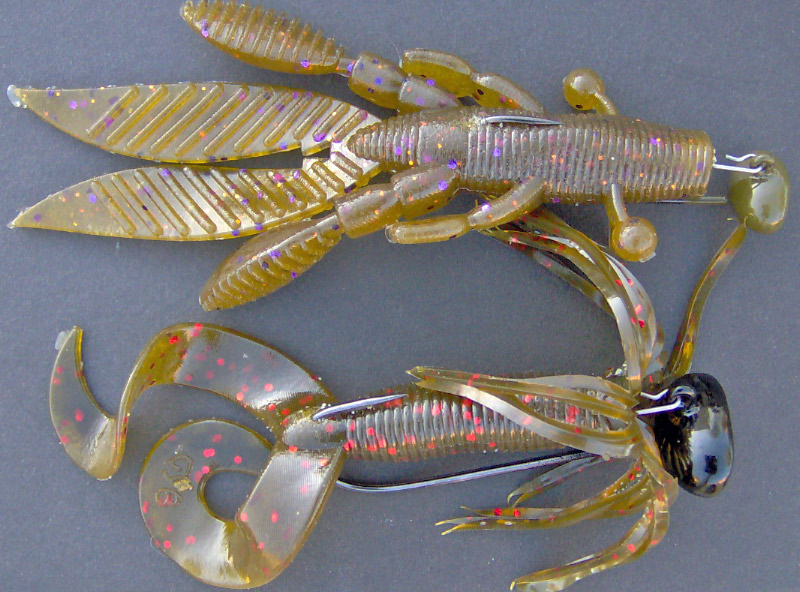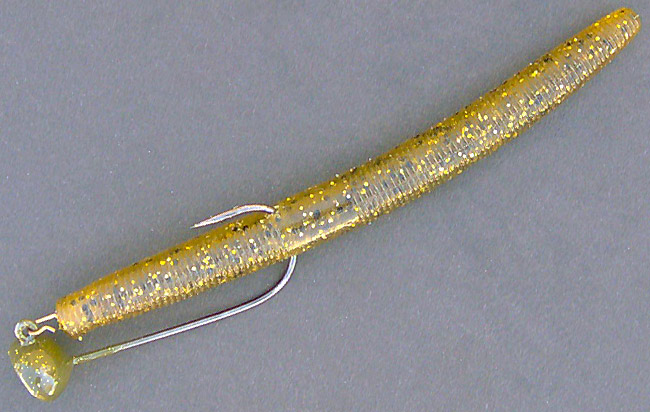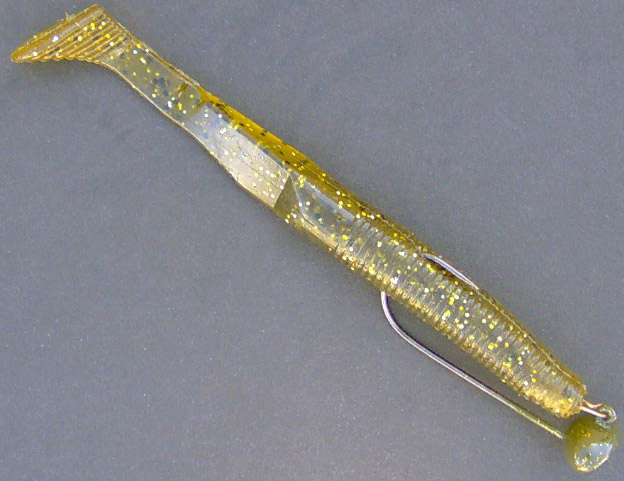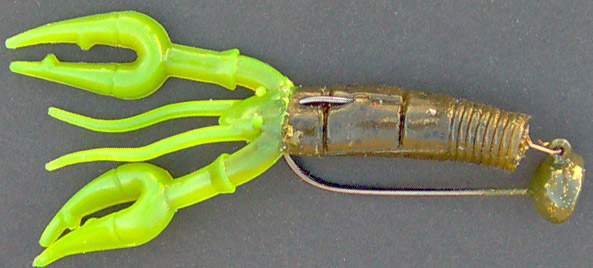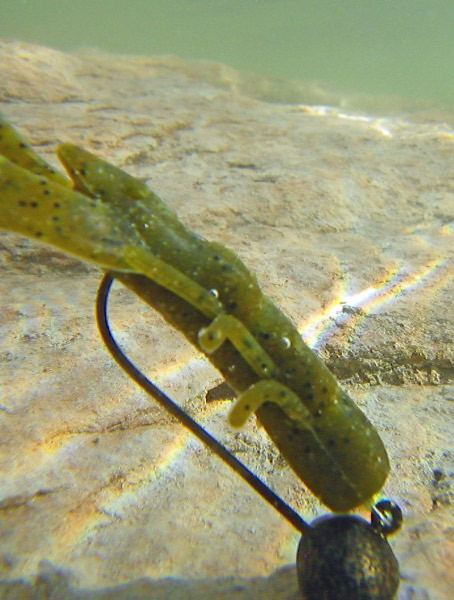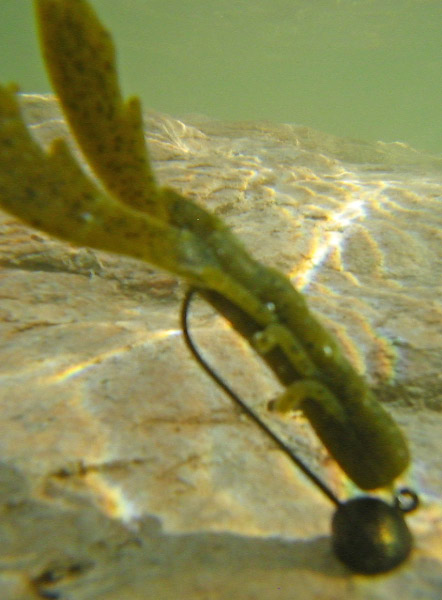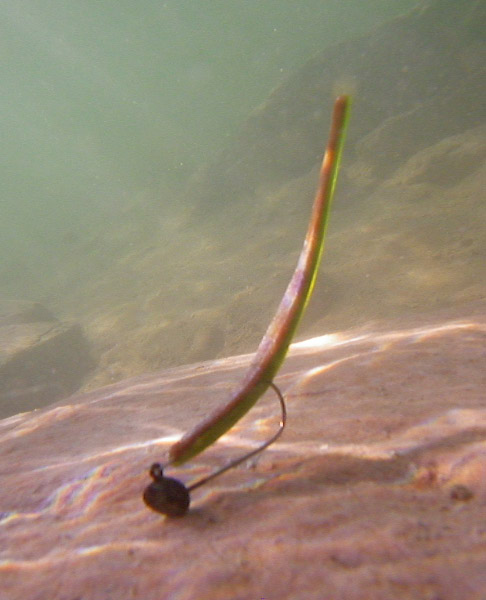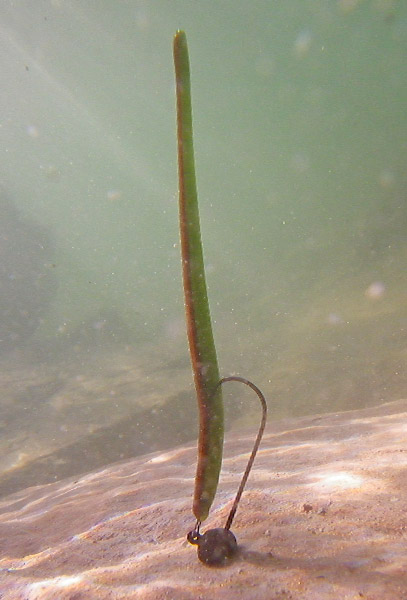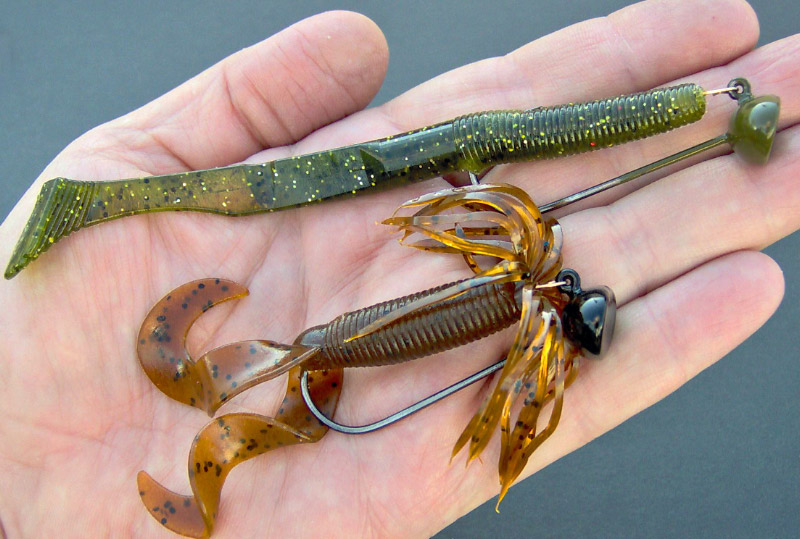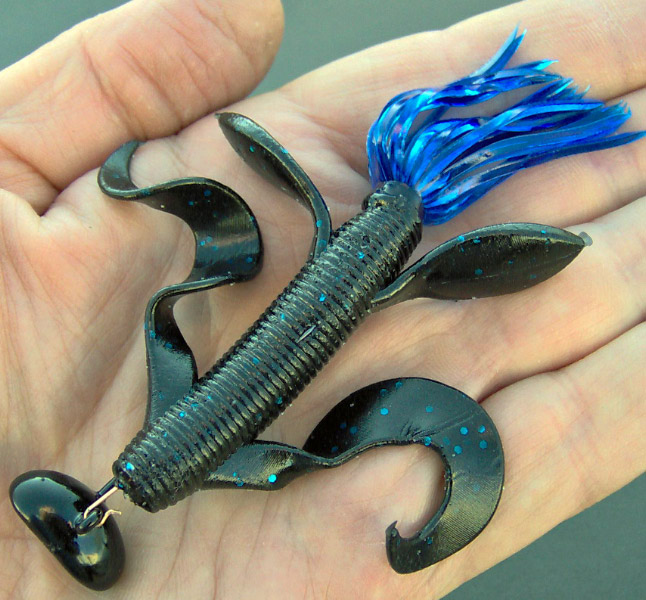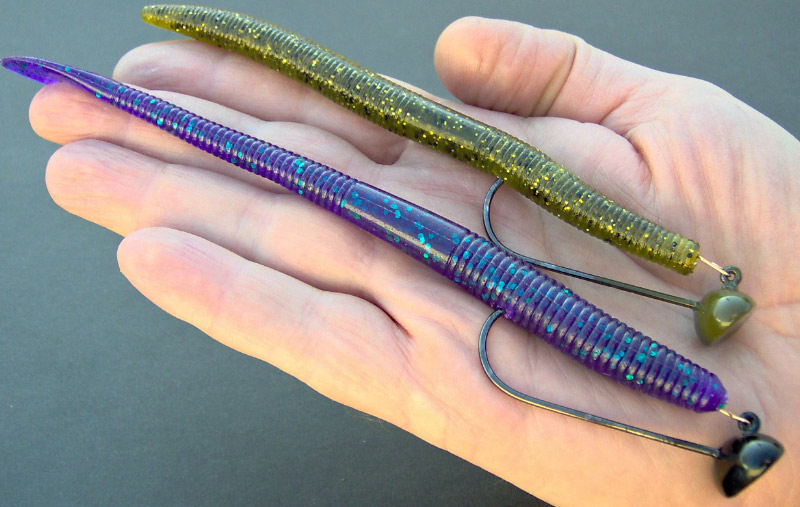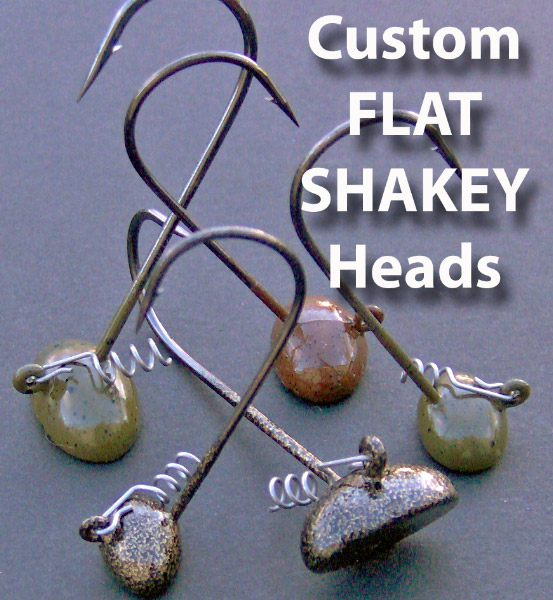 Hook: Mustad UltraPoint. Long shank. Black Nickel.
As far as I know, these are the industry's original stand up football style shakey jigs. I know this because Cast Industries, the company that molds mine, also molds many other brands on the market. This was the first Cast ever made of a shakey football style. There were fully-round and half-round/half-flat ball head shakey jigs at the time, but no football or flat football shakey jigs, This was the first to our knowledge - and still the best, I believe. One of the reasons for the flat face is for the jig head to stand up - and the Bassdozer Flat Shakey Jig does stand up better than any others I've seen. However, my flat face does much more than provide a surface to stand up. It also gives a wicked wiggle with the right worm on the fall and even a squiggle, tick or quiver on the retrieve. It just makes more surface area for water to push against, and that translates into little twitches and shimmies of action when water pushes against the flat face on the fall or on the retrieve. My flat-face is also different from all the others since it is also designed to have a "snow plow" effect when moving over the bottom and to have a "slamming" strike-triggering effect when it encounters any underwater debris. I can just look at photos of other brands of flat-faced football jig designs, and I can see where they aren't built for these features. So not all flat football shakey jigs are made the same! Another first is that, no one else was using the free-swinging clip at the time. It's true that molded-in wire coils were being used, molded into the back of the head - but that is definetly not the best application of the wire coil. A shakey jig with a free-swinging wire coil has several advantages versus fixed wire coil molded in the head. The free-swinging clip on the hook eye, so simple as that sounds, is the very best option for lure flexibility in terms of self-centering, bait positioning, hooking the bait, action, durability and hooksetting. So again, not all shakey jigs are made the same! Obviously they can stand up, but the overall action due to the flat face is a lot more versatile than just standing. The jig only stands at rest, and even then, only momentarily. When the line is pulled, the "pull point" of the line tie eye lifts the head up so it crawls or glides across the bottom with a tight line. When you stop pulling the line, it noses down and stands up again. Most people refer to this tail-up standing posture as a craw in a defensive stance. Every time you stop pulling the line, it noses down on bottom and stands up again. However, this is also exactly how fish feed, by nosing down over a meal on the bottom. Even bass feed this way, by putting their noses down, their tails high up, in order to pluck a meal off the bottom. So the tight-line, sliding, gliding and then sudden stand-up action and nosing down when the line is relaxed, that's exactly how fish feed on the bottom - and if there's one thing that infuriates bass, it is to see a smaller critter brazenly feeding in front of them. It causes a pecking order instinct reaction from the bass to peck or strike the jig that's "feeding" out of turn. Design GoalsAs you can see by many others out on the market today, the basic idea of the flat football shakey stand-up jig has become one of the most popular designs. There are so many others like it on the market now. Of course, shakey jigs are not rocket science but there are detailed points to making a superlative jig that really do make a difference - as simple as they look. There are a few significant features I worked on that look very, very simple on the Bassdozer Flat Shakey Jig, but a lot of others just don't have these concepts designed into them. The design concepts, features and actions I put into the Bassdozer Flat Shakey Jig are:
Russ Bassdozer says: "As you may realize by now, there is more to my Flat Shakey Head design than just standing up on the bottom!"
Give them a try! Most anglers who have, they tell me like them. Importance of the Initial FallMost brands of finesse worms will shake and squiggle to some degree on the initial fall toward bottom. Your worm will often get belted before it even reaches bottom. When a worm does hit bottom, it is often an abrupt stop, and the tail of the worm still wants to keep going even after the head has stopped. This makes the worm act as if it's been stunned by the bottom impact. Keep in mind, since this is a broad bean shape head, it will keep your worm perched atop the bottom and out of snags that would otherwise engulf and bury ball head or other jig head shapes. Most often, the jig here will stand the worm up initially after its been stunned by the impact, and then some additional body movement tends to happen as the worm folds over in half or slowly lays down. Between the squiggling initial fall, the sudden stunned convulsion as it hits the bottom, standing up and then keeling over after a momentary pause, there's not much else you need to do here at times except set the hook and reel in the fish! If there is no hit during the initial fall, additional lifts and drops and hops all cause finesse worms to shake and shudder and swim unpredictably, never the same way twice as they are raised a few feet up and then allowed to fall back to bottom. Even on a steady retrieve, finesse worms tend to squirm and swim when retrieved at a moderate speed on this shakey jig. On the retrieve, while the worm is swimming back to you, you can throw in jerks and pops and pauses just like you would retrieve a hard plastic lipped jerkbait, and this jig head will cause the finesse worm to act like a jerkbait does. It is the unpredictable and non-repetitive pattern of shakes and shimmies that causes this jig head to be truly great, and to fool fish into thinking the worm is alive. It does look alive. It's not a mechanical repetitive movement like a wide-wobbling crankbait. You can perhaps say it is more like a tight-swimming hard plastic lipped jerkbait, except this shakey jig starts and stops, at first a tight shudder, then suddenly more of a wiggle, and never quite the same way twice. This is exactly the unpredictable start-and-stop, fast burst then slow glide series of moves a live baitfish would make. The description above, that is the best way to fish this shakey jig since it does the shaking for you on the initial fall and when you lift and drop it. Keep in mind, you want to maximize or facilitate this jigs ability to do the shaking for you. So how you let it drop, lift and fall or retrieve should all be aimed at getting the shakey jig to shake the worm itself. There's a little knack to getting the jig to activate that built-in shake, but with a little practice, you'll learn how to do it. Additionally, you can also use any of the tactics used with any other shakey jigs. You can shake the rod as it falls. Shake it as it's on the bottom. Drag it without shaking. You can do absolutely nothing as it falls and deadstick it on bottom for what seems like forever. You can cast out, engage the reel, and let it pendulum arc back to you through the water column. Especially to pendulum down roughly following a sloping bottom structure is an easy, surprisingly effective, yet little-used technique. We already describe swimming it back to you, throwing in an occasional rod flick, or simply swim it straight and steady. What you want is for it to squiggle unpredictably as it swims. Overall, the biggest misconception about shakey jigs is you need to shake them. You do not. You could never shake a shakey jig even once, and still catch as many or more fish as those who shiver the spit out of them. It's the same thing often said how to fish a dropshot rig, to shake it. Yet I've never shaken a dropshot yet, and catch as many or more fish than those who shake it. Yes, shaking a shakey jig (or dropshot) will catch fish, even win tournaments, but don't feel obligated to shake it. Be versatile. About the Clip-on Wire Corkscrew KeeperA separate corkscrew keeper coil is used to clip to the hook eye. You screw the worm head on, and then the super sharp point of the extra long shank hook can be buried and hidden Texas-style within the worm. Now you're ready! There's really no reason to ever unclip the coil, but if you do, spread the clip loop open slightly with your thumbnail to remove it. Squeeze the clip loop closed again with your thumbnail once you clip it on again. It should never really come off (squeeze it shut) and it does not interfere with the fishing line or knot. Best of all, a worm cannot easily be pulled off the keeper coil by a fish, and the coil does not tear a worm up as much as other barbed keeper types or jig head collars. It truly is a great approach! The free-swinging coil also helps the worm shake by itself. There is not much of the worm body that is fixed or "frozen" by this set-up. The corkscrew coil goes into the head only about 1/4" is all, yet it holds the worm more securely than most anything else. Only 1/4" of the worm is fixed, and then the small section where the hook point is buried in the worm. The entire rest of the worm body is free to squirm, not threaded on the jig hook, and since the coil itself is loosely clipped on instead of fixed immovable on the jig, the worm is really held in free-floating suspension, so it can squirm and shake more than on other types of shakey jig heads. A Few Words on WormsShakey jig heads are first and foremost used with finesse worms. Long, slender worms in the 5 to 6 inch range seem to shake the best with the 1/4 and 3/8 oz size shakey jig heads. Smaller 4 inch worms can be rigged on the 3/16 oz size. The 3/16 oz size is better matched to 6 to 8 pound test and a slightly more limber rod. The 1/4 oz size is suitable for a range of 6 to 10 pound test. The 3/8 oz size fits best with 8, 10 and even 12 pound test. Different brands and models of worms act differently. It is well worth it to experiment to see the different shakes, shimmies and squiggles that different brands, sizes and styles of worms will make on this Shakey Jig head. You should try your favorites to see how they perform.
Shaking with Other Soft Plastic ShapesOf course, the shakey jig's not just limited to worms. You can Texas rig craws, tubes, grubs, hula grubs, lizards or most any other soft baits on this Shakey Jig. See for yourself if this isn't one of the best 6 to 10 pound test range jig head applications you've ever used - bar none. And best of all, it's a jig tactic but the bait is Texas rigged to be weedless and snagless.
No matter what soft bait shape you use, the results may often be "flat" out too much fun with Bassdozer's Flat Shakey Jigs rigged with many different soft baits. Rigging Suggestions
Underwater Photos
|
Extra Strong Shakey Jigs ~ 4 per Pack
Get ready for Power Fishing with a Shakey Jig!
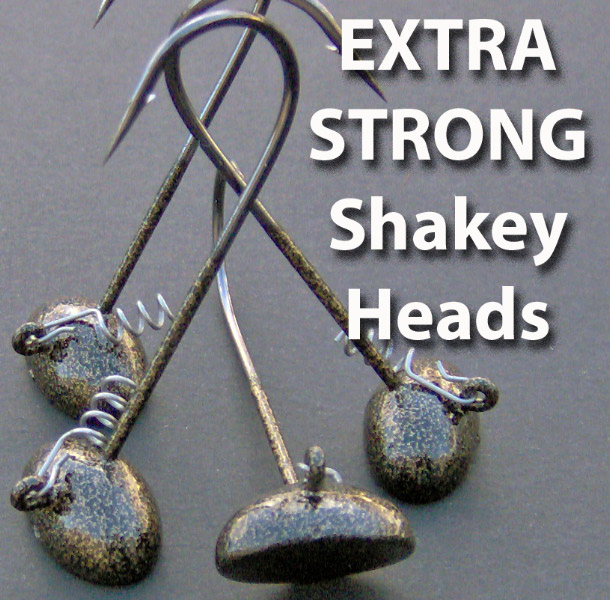 Style: Flat Shakey Head ~ X-Strong Note: There are two different strength hook models:
It is now possible to power fish with shakey jigs using the heaviest rod. reels and line possible including up to 65 lb test braided line. As heavy braided line continues to become more popular with anglers and as deeper-dwelling big bass are increasingly targeted by anglers, it's only natural to offer a power fishing version of the my Shakey Jig that can hold up to the biggest bass on the heaviest bass tackle. Here it is. My Extra Strong Shakey Jig for power fishing is available in a 1/2 oz size with a 6/0 Gamakatsu heavy duty hook that's suited for heavy rods and up to 65 lb braided line is fine. It includes a wire corkscrew clip-on keeper coil. Simply clip the coil to the eye of the hook and screw the head of the bait onto it. My Extra Strong Shakey Jigs have a super strong Gamakatsu 6/0 hook for heavy line, stout rods and big bass. This 6/0 Gamakatsu is suited for the heaviest bass possible on heavy tackle. This is a flipping strength hook. The heavy nature of the hook requires heavy or extra heavy rod, reel and line - at least 16-20 lb test mono or fluoro (at a minimum), and up to as heavy as 50 to 65 lb test braid. Yes, you can use finesse worms with this power shakey jig - and fish finesse worms on this jig with heavy tackle. Or you can use a little beefier models of worms and soft baits as shown below. Remember, bigger bass love bigger baits!
Bassdozer says: "Pay attention to how you insert the hook into the bait. It is not inserted at the same angle used when rigging an offset shank worm hook. With a shakey jig and wire clip, the hook point is inserted on more of a horizontal angle through the bait's body. Be aware of this difference as to how the hook lies within the worm, and more importantly, how the strike and hookset needs to unsheath the point and pin a bass. With the corkscrew clips, this is a little different (and better) set-up than a typical worm hook, and therefore you will find that a little different rigging and hookset is needed - just pay attention to what's going on when you rig the bait and set the hook, and you will be fine with it." |

